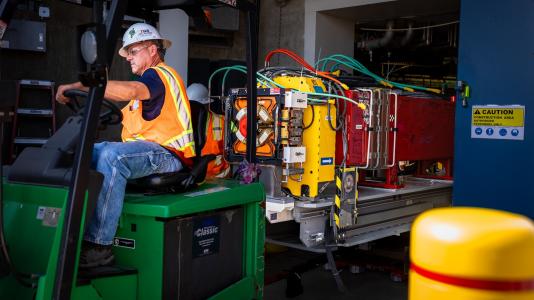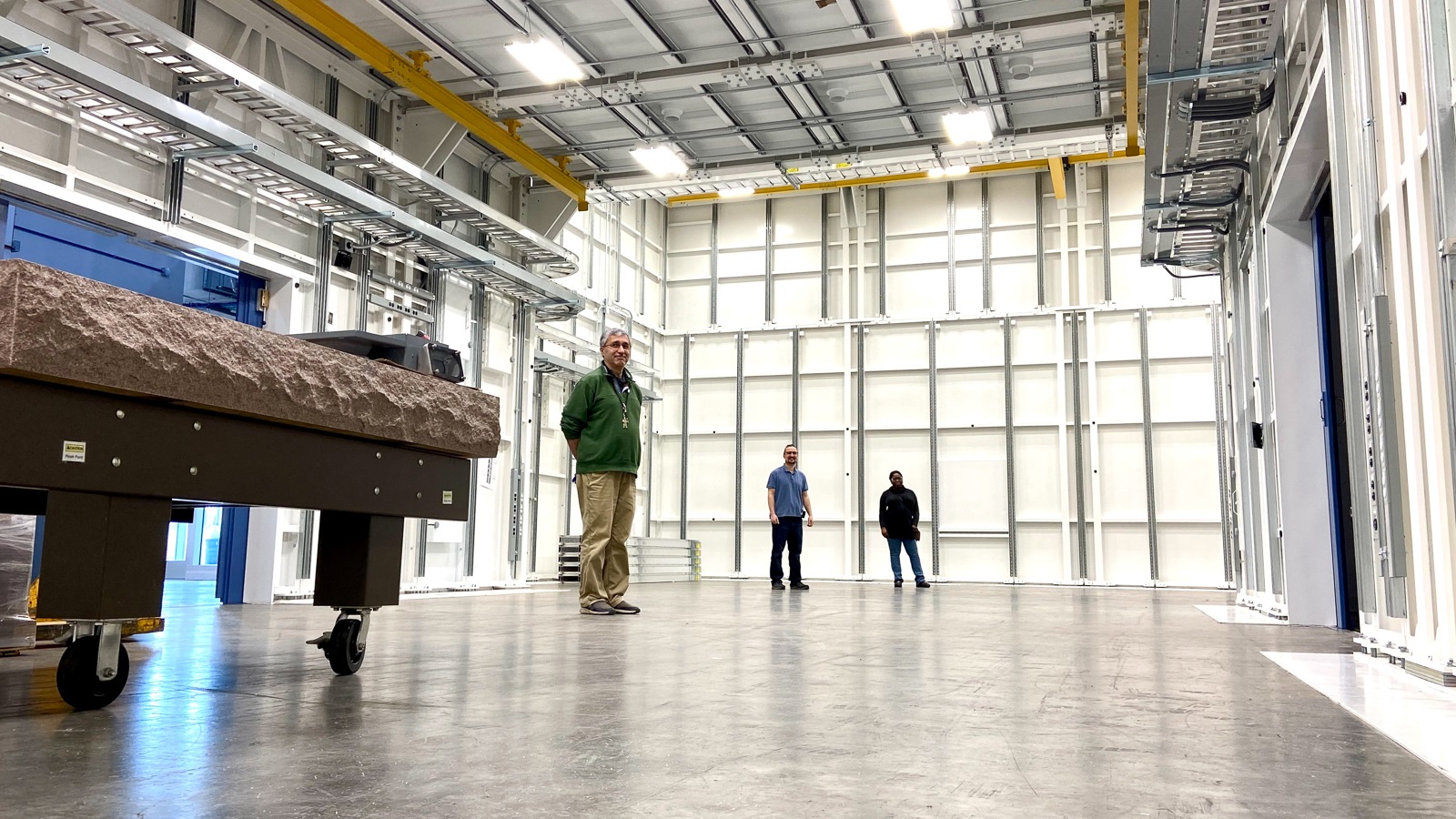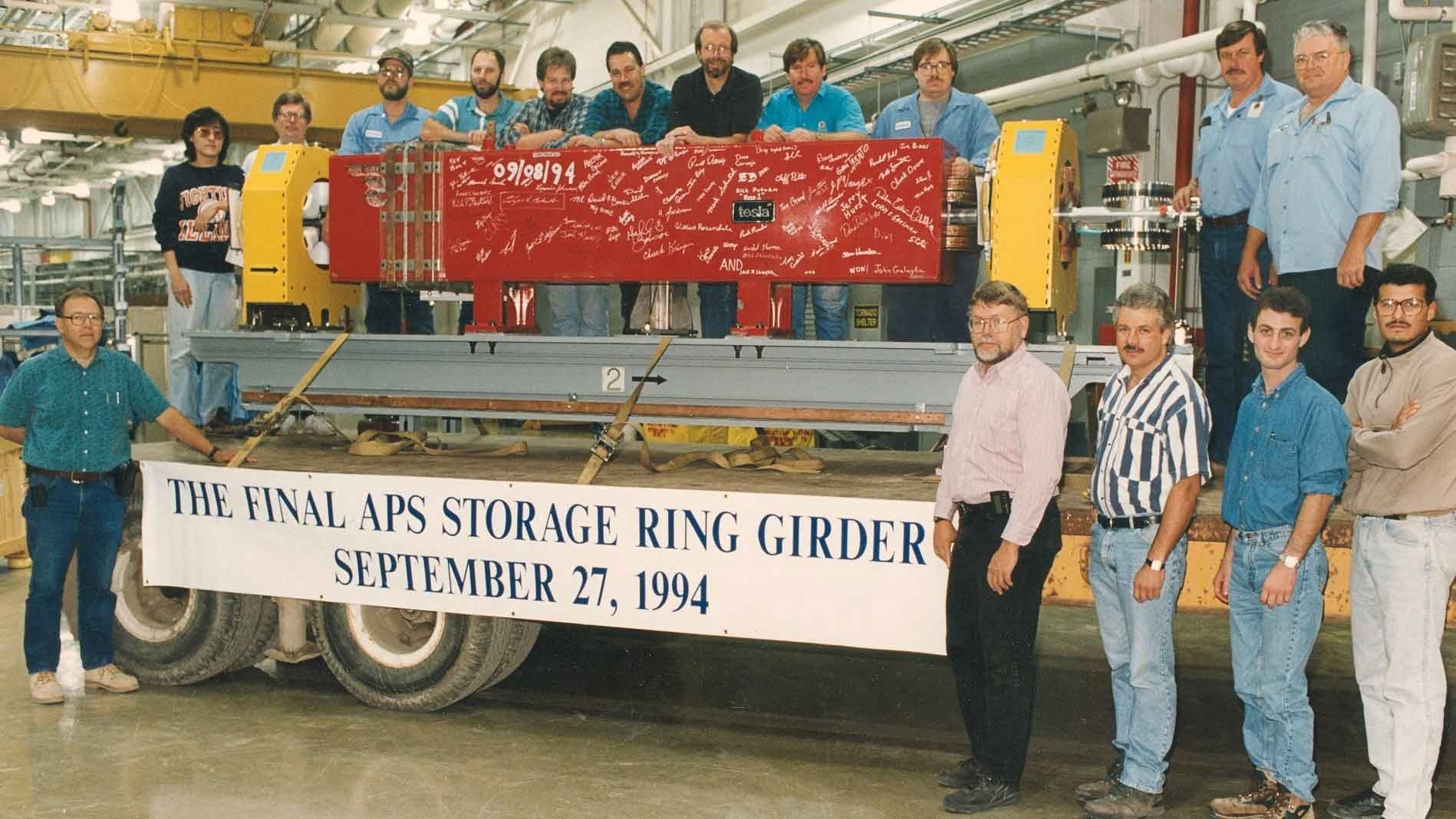BY CHRISTINA NUNEZ | JULY 5, 2023
For over a decade, teams have been working to design and prepare for the rebirth of the APS. Now, the moment is here.

Over the past three years, thousands of machine parts have been delivered to a low-slung, deceptively plain building in Lemont, Illinois. Once a warehouse, Building 981 is now a workshop — an extremely sophisticated one. Inside, a multitalented team assembles the building blocks of a complicated yet elegant machine, one that will sit at the heart of the Advanced Photon Source (APS), a U.S. Department of Energy (DOE) Office of Science user facility at DOE’s Argonne National Laboratory.
This new machine is part of a comprehensive upgrade to the facility, one that will set it at the forefront of global X-ray science for decades to come.
More than 5,500 scientists in a typical year use the APS for its intensely bright X-ray beams. Since it began operating in the mid-1990s, the APS has enabled advances in the fields of medicine, energy, climate, physics and more. The drug Paxlovid, devised to treat COVID-19, emerged from work at the APS. So did two Nobel Prizes in chemistry. These and many other breakthroughs have resulted from the APS’s ability to illuminate the otherwise invisible.
“The APS Upgrade opens up possibilities that could not be envisioned till now.” — Suresh Narayanan, Argonne Physicist
Now comes a moment more than a decade in the making. The APS’s powerful engines shut down on April 24, to make way for this new machine, called a storage ring, which circulates electrons in order to deliver X-ray beams up to 500 times brighter than the current one. That required first dismantling the existing storage ring, which spanned about two-thirds of a mile around. This phase of the project is now complete. The next phase will see the new components from Building 981 — preassembled into 200 modules weighing up to 50,000 pounds each — moved in this summer, when installation will begin in earnest.
(Video by Argonne National Laboratory.)
Brighter = Faster
The increase in APS brightness, along with an array of new and updated experiment stations, will make it easier and faster to conduct a wide range of science at the APS. How? Imagine trying to observe a leaf on a moonless night versus during the daytime, says Jim Kerby, APS Upgrade project director. In darkness, eventually you would make out the leaf’s contours and color. During the day, however, you can instantly detect many of the leaf’s features, from its veins and texture to a tiny insect crawling on the surface.
Brighter beams and state-of-the-art equipment will enable science that simply cannot be done today, according to Jonathan Lang, director of the X-ray Science Division (XSD) at Argonne.
“Some of the questions scientists would like to answer would require experiments that would take weeks to carry out,” Lang said. “But the APS is in such high demand that researchers rarely get this much time for experiments. With the upgrade, measurements such as these could be done in a few hours, so experiments that are not even considered now will become routine in the future.”
The APS works by circulating electrons around the storage ring, where they are steered and the electron beam is focused by magnets of various types. At certain locations around the ring, the electron beam bends, causing it to emit photons, which are particles of light. These beams of photons are channeled into 68 experiment stations, called beamlines, at the facility, each tuned to a enable a specific type of scientific experiment.
The new storage ring will incorporate 1,321 magnets, many stronger than the departing ones. But strength accounts for only part of the upgraded machine’s power. The design features reverse-bending magnets that occasionally draw the electron stream slightly to the left and away from its normally rightward-veering course around the storage ring, creating a beneficial “wiggle” in the beam. The magnets, along with improvements in power systems and materials over the past few years, allow for a smaller and more focused electron beam, producing brighter light.
The upgraded APS will also have a series of new feature beamlines, all of which were developed based on the needs of the scientific community. In addition to those, all the existing beamlines at the APS will receive new components to make use of the brighter beams.
Both the new and existing beamlines will receive the latest generation of specialized optics and instruments to optimize and measure the X-ray beams, said Robert Winarski, an Argonne physicist who is the beamline installation coordinator for the upgrade. Some components are so sophisticated that they require years of engineering development and intricate fabrication techniques.
“The APS storage ring produces the X-rays. The APS beamlines produce the science — individualized techniques, all a little bit different, all producing world class research,” Winarski said. “With the upgrade, measurements that used to last minutes or hours will now take seconds or even fractions of seconds. You’ll be getting incredible amounts of data that you couldn’t get before.”
Zeroing In on New Science
Two of the new beamlines will be housed in the aptly named Long Beamline Building, which sits just beyond the perimeter of the current facility. The extra distance allotted for the In-Situ Nanoprobe (ISN) and the High Energy X-Ray Microscope (HEXM) allows for X-ray properties and experiments not possible with the current facility.

ISN is designed for high-resolution imaging in situ, meaning materials can be observed in a realistic environment under changing conditions. This capability will benefit researchers such as Sarah Wieghold, an Argonne assistant physicist who studies materials for solar cells.
Wieghold looks for signs of degradation in a solar cell that could reduce its ability to convert sunlight into energy we can use. At ISN, she can expose materials to different conditions that solar cells would encounter when in use, such as light and heat. Then she can observe how they hold up over time, watching for changes among ions, or tiny particles within a material.
“Within our experimental solar cells, ions migrate and cluster together, creating small defects in the material. And right now, we just cannot see it,” Wieghold said. “At the higher resolution that we will have at the upgraded APS, you can track those changes on a totally different level.”
HEXM will feature a very large end station — the chamber where samples and detectors are placed — measuring 20 meters (66 feet) long. That will allow researchers to examine a range of large, dense materials, also in situ.
“HEXM can be used, for example, to study the earliest stages of crack initiation in airplane engine blades under stress and heat, or to see where hot spots form in full-size batteries as they charge and discharge,” said Jonathan Almer, an Argonne physicist. “This unique, 3D data will inform design of better-performing materials in a wide range of areas, particularly related to sustainable energy.”
Years of work have gone into the upgraded beamlines, some of which have already been built out and tested, Winarski said. All of them involve extremely high-precision instrumentation and positioning. He points to the Coherent Surface-Scattering Imaging (CSSI) 9-ID beamline as an example. CSSI is designed to explore top-layer phenomena at minuscule scales on samples like biological cells and thin-film coatings. It will have a movable detector that tracks the X-ray beams as they scatter off samples that might span less than a few micrometers — smaller than a strand of spider’s silk.
“We’ve got to project a spot size that’s just a few micrometers wide from 4.5 meters [15 feet] away. Then you need to capture the data from that spot in a movable, 2.5-meter [8-foot] steel tube,” Winarski said. “These are daunting engineering tasks.”
Keen Focus on the Goal

Hundreds of Argonne employees, contractors and vendors have been working together for several years to plan for, design and build the new facility.
“There are a lot of moving parts here and a lot of people,” said Elmie Peoples-Evans, project manager for the $815 million upgrade. “Coordination is key. We want to make sure we’re communicating to everyone what’s going on. Most importantly, we want to make sure everything’s done safely.”
Any undertaking as complex as the APS Upgrade is bound to encounter curve balls and setbacks. When planning began about a decade ago, however, it was impossible to foresee the massive disruption that 2020 had in store.
“When we first started planning the project, we had a solid plan that we thought we could execute,” Peoples-Evans said. “We were headed in that direction until the COVID-19 pandemic occurred. After that, we had to get a little creative.”
Hundreds of specialty vendors from across the world, with the majority in the United States and Europe, have been critical to the upgrade project. But many have faced supply chain disruptions brought on by the pandemic and all the economic challenges that followed. The APS Upgrade team kept the project on track both by bringing on additional suppliers and connecting existing vendors with new sources for necessary parts.
As the pieces came in, engineers at Building 981 finally began to construct designs that had been envisioned and refined over a decade. For Jason Carter, an Argonne engineer who has been working on the upgrade since the beginning, the moment is an exciting one.
“It’s 100 percent a team-oriented space — technicians, engineers, physicists and beyond, all goal-oriented toward making our coming installation a success, and doing it all on schedule,” he said.
Carter’s team is building the vacuum system that surrounds the electrons as they circulate through the storage ring. Their path requires an airtight, clean environment with vacuum pressure levels comparable to the those felt in outer space. To that end, part of Building 981 has been converted to clean rooms, where workers don gowns, gloves, hair nets and shoe covers to keep contaminants out.
“Preservation of cleanliness is critical,” Carter said. “These vacuum chambers have to be welded carefully. A single fingerprint on the inside of our system would be enough to cause problems.”
Meanwhile, Argonne engineer Fernando Rafael and team have been receiving and testing the equipment that will power the system, including more than 3,000 power converters.
Even though the new APS will be 500 times brighter, it will require less energy to operate. That’s partly because of the more compact system design and partly because of efficiency increases in power electronics over the past three decades, according to Rafael.
“In the past, typical efficiency for power electronics equipment was 80 or sometimes 90 percent,” he said. “Nowadays, we specify our power electronic equipment with efficiency above 95 percent.”
Equipment failures are likeliest to occur at the beginning and end of a product’s life cycle. To lower the possibility of the early failures, Rafael and team run equipment in a hot room to stress-test it.
Now comes the installation phase. “Every day will bring a new challenge, between managing contractors, assigning resources and troubleshooting any issues that come up,” he said. “We have a large number of power electronics to be installed, and we have to do it safely.”
Out With the Old
The existing storage ring machinery will be taken apart and trucked out over the next three months or so. Mark Erdmann, the project’s removal and installation coordinator, is overseeing that effort. He’s well suited for the job, given that he worked on the installation of the original APS in the mid-’90s.

“One of the biggest issues is logistics,” Erdmann said. “When the first machine was installed, there was nothing there — we had all the space in the world. It was easier to install and move things around.”
This time, Erdmann and his team are mapping out an intricate choreography to make sure that every piece, both existing and new, gets where it needs to go. Some parts will be refurbished and will go back into the upgraded APS, or into other scientific facilities. Others will not be reused and will be disposed of, but only after being thoroughly decontaminated and checked — twice. One check happens at the point of origin, another at a station containing sensors that trucks drive through on their way in and out of Argonne.
“Every piece of equipment has its own path,” Erdmann said. “We use QR codes and a component database to track everything.”
Excitement and Unknowns Ahead
Researchers such as Suresh Narayanan, a physicist in XSD, eagerly await the upgrade. Narayanan and team study a variety of materials at the molecular and atomic level. These include hard materials like glasses and metals and soft ones like gels and foams. Their work has implications for everything from wearable electronics to coatings and medicines.
“The APS Upgrade opens up possibilities that could not be envisioned till now,” said Narayanan, who is overseeing two new beamlines at 8-ID and 9-ID. “In addition to the scientific areas we have studied so far, areas such as energy storage, biomaterials, high pressure research, glasses, quantum materials and oxides will reach new horizons.”
(Video by Argonne National Laboratory.)
Measurements gathered at the light source also benefit from the advent of technologies such as automation and machine learning, Narayanan added. Taught to recognize patterns and mine data, computers will help scientists zero in on the most important insights.
This is where Argonne’s high performance computing capabilities will be crucial. The new exascale supercomputer Aurora, along with current resources at the Argonne Leadership Computing Facility (ALCF), a DOE Office of Science user facility, will be needed to process data coming out of the new APS.
“After the upgrade, the facility will be generating data at incredible rates. Users will want to run an experiment, analyze the data, identify an area of interest, and then run the next experiment in almost real time. That will take major computing power and expertise,” Kerby said. “Fortunately, with both the APS and ALCF, Argonne is uniquely positioned to answer this challenge.”
The upgraded APS is scheduled to begin initial operations in April 2024, reaching full power 16 months afterward. The ramp-up will be gradual, says project director Kerby.
“There’s not a big Frankenstein switch which turns everything on at once,” he said.
Before any electrons are injected, each system must be fully tested and checked out. After initial storage ring operations, the team will raise the beam power incrementally, but only after confirming the facility is safe at each step.
Kerby likens the adjustment period for the upgrade to taking the wheel of an F1 racecar for the first time: You don’t just hop in and start driving, even though you’ve driven a car before. The learning curve will extend to both Argonne staff and facility users, but it carries thrilling prospects for the science to come.
Erdmann was maintaining and improving beamlines before he began working on the APS Upgrade. He expects that a return to his operational role will involve a slew of adjustments to make the most of this powerful machine.
“This is just the beginning,” he said. “The upgrade may be considered finished in a year. But in reality, it will be going on for a long time.”
About the Advanced Photon Source
The U. S. Department of Energy Office of Science’s Advanced Photon Source (APS) at Argonne National Laboratory is one of the world’s most productive X-ray light source facilities. The APS provides high-brightness X-ray beams to a diverse community of researchers in materials science, chemistry, condensed matter physics, the life and environmental sciences, and applied research. These X-rays are ideally suited for explorations of materials and biological structures; elemental distribution; chemical, magnetic, electronic states; and a wide range of technologically important engineering systems from batteries to fuel injector sprays, all of which are the foundations of our nation’s economic, technological, and physical well-being. Each year, more than 5,000 researchers use the APS to produce over 2,000 publications detailing impactful discoveries, and solve more vital biological protein structures than users of any other X-ray light source research facility. APS scientists and engineers innovate technology that is at the heart of advancing accelerator and light-source operations. This includes the insertion devices that produce extreme-brightness X-rays prized by researchers, lenses that focus the X-rays down to a few nanometers, instrumentation that maximizes the way the X-rays interact with samples being studied, and software that gathers and manages the massive quantity of data resulting from discovery research at the APS.
This research used resources of the Advanced Photon Source, a U.S. DOE Office of Science User Facility operated for the DOE Office of Science by Argonne National Laboratory under Contract No. DE-AC02-06CH11357.
Argonne National Laboratory seeks solutions to pressing national problems in science and technology. The nation’s first national laboratory, Argonne conducts leading-edge basic and applied scientific research in virtually every scientific discipline. Argonne researchers work closely with researchers from hundreds of companies, universities, and federal, state and municipal agencies to help them solve their specific problems, advance America’s scientific leadership and prepare the nation for a better future. With employees from more than 60 nations, Argonne is managed by UChicago Argonne, LLC for the U.S. Department of Energy’s Office of Science.
The U.S. Department of Energy’s Office of Science is the single largest supporter of basic research in the physical sciences in the United States and is working to address some of the most pressing challenges of our time. For more information, visit https://energy.gov/science.
